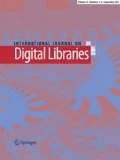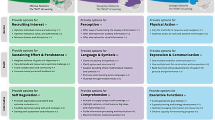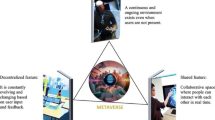Abstract
This paper describes work in progress on the research project CWSpace, sponsored by the MIT and Microsoft Research iCampus program, to investigate the metadata standards and protocols required to archive the course materials found in MIT's OpenCourseWare (OCW) into MIT's institutional repository DSpace. The project goal is “to harvest and digitally archive OCW learning objects, and make them available to learning management systems by using Web Services interfaces on top of DSpace.” The larger vision is one of complex digital objects (CDOs) successfully interoperating amongst MIT's various learning management systems and learning object repositories, providing archival preservation and persistent identifiers for educational materials, as well as providing the means to richer shared discovery and dissemination mechanisms for those materials. The paper describes work to date on the analysis of the content packaging metadata standards METS (Metadata Encoding and Transmission Standard) and especially IMS-CP (IMS Global Learning Consortium, Content Packaging), and issues faced in the development and use of profiles, extensions, and external schema for these standards. Also addressed are the anticipated issues in the preparation of transformations from one standard to another, noting the importance of well-defined profiles to making that feasible. The paper also briefly touches on the DSpace development work that will be undertaken to provide new import and export functionalities, as the technical specifications for these will largely be determined by the packaging metadata profiles that are developed. Note that the degree of interoperability considered herein might be referred to as “first level,” as this paper addresses the packaging metadata only, which in turn is the carrier or envelope for the descriptive (and other kinds of) metadata. It will no doubt be an even more challenging task to ensure interoperability at what might be referred to as the “second level,” that of semantic metadata.
Similar content being viewed by others
References
METS http://www.loc.gov/standards/mets/ See also ``METS Structure Diagrammed'' http://sunsite3.berkeley.edu/mets/dia-gram/ (2005)
IMS-CP IMS Global Learning Consortium, Content Packaging Best Practice Guide http://www.imsglobal.org/content/packaging/cpv1p1p4/imscp\_bestv1p1p4.html
MIT OpenCourseWare (OCW). http://ocw.mit.edu (2005)
DSpace http://www.dspace.org (2005)
MERLOT http://www.merlot.org/Home.po (2005)
LOLA http://www.lolaexchange.org (2005)
GEM http://www.thegateway.org/ (2005)
CONNEXIONS http://cnx.rice.edu/ (2005)
EDUSOURCE http://www.edusource.ca/english/home\_eng.html (2005)
CAREO http://www.careo.org/ (2005)
Yee, R.: Semantic Interoperability Problem. (2003) Accessed August 22, 2005, from the World Wide Web: http://raymondyee. net/ wiki/SemanticInteroperabilityProblem
Godby, C.J.: What Do Application Profiles Reveal about the Learning Object Metadata Standard? (2004) Accessed August 22, 2005 from the World Wide Web: http://www.ariadne.ac.uk/ issue41/godby/
Wiley, D.A.: Connecting learning objects to instructional design theory: A definition, a metaphor, and a taxonomy. In: Wiley, D.A. (ed.), The Instructional Use of Learning Objects, p. 29 (2000) (online version). Retrieved December 6, 2004, from the World Wide Web: http://reusability.org/read/chapters/wiley.doc
IMS Global Learning Consortium, Learning Object Metadata (LOM).http://www.imsglobal.org/metadata/mdv1p3pd/imsmd\_be-stv1p3pd.html; IEEE WG12: Learning Object Metadata http:// ltsc.ieee.org/wg12/ (2004)
MIT SIMILE project (Semantic Interoperability of Metadata and Information in unLike Environments). http://simile.mit.edu (2005)
RELOAD (Reusable Learning Object Authoring and Delivery) http://www.reload.ac.uk/ (2005)
Giunti eXact Packager http://www.learnexact.com/l1.php?click = 4 (2004)
HarvestRoad Explorer http://www.harvestroad.com/products/hive-modules.cfm (2005)
Wiley, D.A.: (2000) (op. cit.) p. 7
MPEG21-DIDL ``Multimedia Framework'' and ``Digital Item Declaration Language,'' http://xml.coverpages.org/mpeg21-didl.html (2004)
Bekaert, J.: Using MPEG-21 DIDL to Represent Complex Digital Objects in the Los Alamos National Laboratory Digital Library. (2003) Accessed December 11, 2004 from the World Wide Web: http://dlib.org/dlib/november03/bekaert/11bekaert.html
New York University, Digital Library Team http://library.nyu.edu/ diglib/index.html (2005)
Center for Research Libraries http://www.crl.uchicago.edu/ (2005)
National Digital Information Infrastructure and Preservation Program (NDIIPP) http://www.digitalpreservation.gov/ (2005)
Yee, R., Beaubien, R.: A preliminary crosswalk from METS to IMS content packaging. (2003) Accessed August 22, 2005 from the World Wide Web: http://iu.berkeley.edu/rdhyee/Filer/filetree/ 2004/yee\_beaubien\_mets\_to\_imscp\_paper.pdf
MIT iCampus http://icampus.mit.edu/ (2005)
MIT Stellar http://stellar.mit.edu (2005)
MIT SloanSpace http://sloanspace.mit.edu (2005)
Author information
Authors and Affiliations
Corresponding author
Rights and permissions
About this article
Cite this article
Reilly, W., Wolfe, R. & Smith, M. MIT's CWSpace project: packaging metadata for archiving educational content in DSpace. Int J Digit Libr 6, 139–147 (2006). https://doi.org/10.1007/s00799-005-0131-2
Published:
Issue Date:
DOI: https://doi.org/10.1007/s00799-005-0131-2




